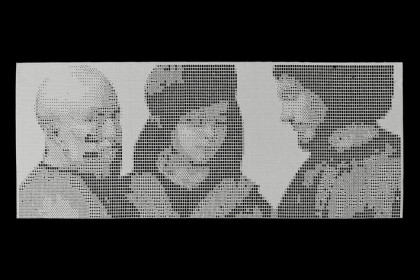
We had an appointment to decide about an exhibition project. Giorgio Tentolini comes running, panting and out of breath. He sits down and starts talking about sagittal sections, opens his leather purse and pulls out pieces of net, gauze, latex, torn folders containing prototypes of those series he entitled Cropped Papers. He also talks about scalpels for graphics, nails, punches for lead. Then he said that the inspiration was born thinking about the relationship between people and food, to the problems that arise from eating too much or eating too little, and that to fully understand the pathological aspects of eating disorders he had long talks with a psychologist friend.
The result is a coherent idea, refined and of great depth, all features that never fail in the work of Tentolini.
A work that is patience and perseverance, search for historical sources and adoption of new materials or use of normal materials at the most usual forms very personal and original. Like the hundreds cardboard strips of different lengths, assembled with precision, to form St. Paul’s head, or like white paper sheets, cut with surgical accuracy and superimposed to tens up giving life to a three-dimensional positive or negative of human bodies, of strangers to whom Giorgio steals form through casual photos, remainders of a spontaneity otherwise unattainable. And yet the perforated PVC nets, long rolls more or less rolled out by figures that reveal a luminous projection, because light and shadow give substance to an evanescent support, light and impalpable. Almost souls in motion.
The people by Tentolini, because at the center of the whole work is almost exclusively the human being, they seem at first sight out of time and history, and instead turn out to be an expression of memory traces in which you will discover the ancient models – Giorgione, Dürer, Masaccio – and are perceived philosophical and biblical references, in a continuous return between past and present, between movement and stasis.
But the second leitmotif of his work is that of time, the past few months to crop and compose, to drill and overlap, in a creating operation in progress that gives depth and spirit that infuses the materials. Rare exception in the choice of subjects: sometimes dilapidated farmhouses of the campaign that is proper, or the Tree of Life of Adam and Eve, reproduced with slight signs of graphite on the uneven surface of a roll of paper one kilometer long.
In front of the work of Tentolini you can think of anything else but the words by Calvino, to the “lightness” which is the main character of American Lessons (1985), which may well have been, and still is, the key to overcome some conceptual art, to bring the thought plans on tracks where the mind can comprehend simultaneously to hear our innermost layers.
 English
English  Italiano
Italiano 



